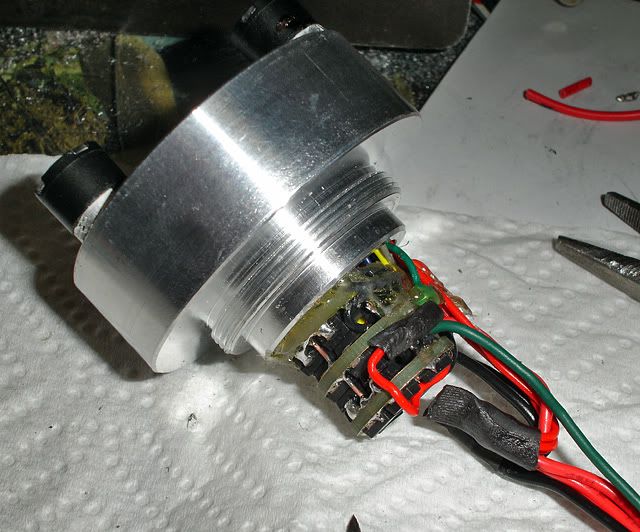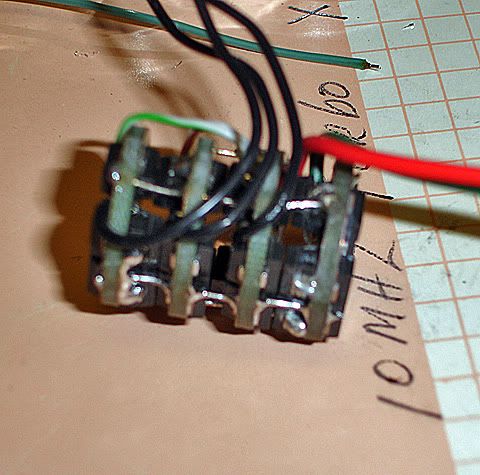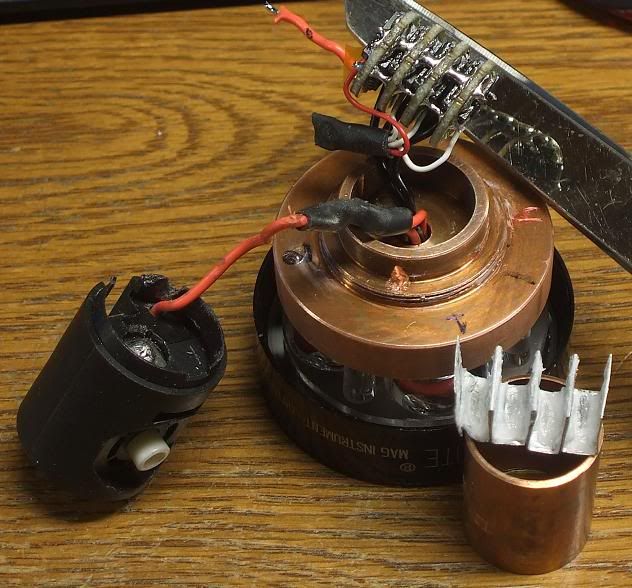Techjunkie is the bomb! He is King of all Ashperic XM-L Mag Mods!
I've said it many times-this recipe works great and I've used it on ~a dozen lights now. Next one I do I'll have to try the switch bypass; all of my lights were done before this came up... don't wanna tear my perfectly pimped lights apart now!  Ideal as I have a few cut-downs that run on one 26650.
Ideal as I have a few cut-downs that run on one 26650.
Rich
If you strip a bit of extra wire (1/4") from the switch-master ground wire for each board and use the hole located between the middle amc 7135 chips you can thread the slave boards onto this and the wire link I mentioned above to make a nice neat stack. A piece of cu or alu AA'd between each board to collect heat from the chips buried in the stack. I have some of these boards from illumination supply. I'll see if it works.
Scott
Do you mean like this?
[/quote]
Here's mine for one of my triples:


I haven't used anything between the boards to heatsink but haven't had any problems either. Had to show off a little here! 
Rich
Updated the first post with the new photos and information from TJ.
Exactly
Yes, that's exactly what I mean. We're you able to use the smaller vias to connect the vdd pins or did you use a wire around the boards, maybe the green one? What voltage are you running? As a practice piece I put 2- 1.4A boards together for a single p7 lite. It's a plastic housing with a 4d battery holder that mimics the shape of a 6V lantern battery. If 4D works then maybe I can use lantern batts instead. If not then I'll make a D-cell spacer and just use 3 D with the holder. The holder has springs for each batt plus 2 more for the holder plus 2 more that make up the switch connections, lots of parasitic resistance sources. I've done lots of mods with bike lights, dive lights, no maglites and no access to a machine shop but I can work with copper.
Scott
I have an Allen dive light. For those who don't know, an Allen light is a big mother cast aluminum dive light with a 1/ 2" thick acrylic lens. The dia. behind the lens is 105mm and it has a D-cell holder for 10 cells and a reed switch. After doing the math there is room for 8 35 mm optics. That could be 8x XML or 32 2p-2p xpg on 4up boards. Other even more insane options loom. What I would like to know is: How many slaves can one processor run. The stock reflector is quite deep so there is room for 10 D li-ion as well with a customized holder. If I build this thing rest assured it will NEVER go on a plane. This is the first thread that gives me hope this doomsday driver might live again.
Three tanna leaves to give him life, nine to give him movement. But what if he eats the whole bag?
Im posting this in this thread as it pertains to accomplishing this mod but if it gets moved so be it. Ordered a hobby hand drill w/ very small bits to ream out vias(the gold lined holes that link the traces on one side with those on the other)and link the boards with posts instead of wires. The ground vias are big enough but the other vias are too small to get a wire of sufficient dia. to carry enough current. I'll have to make sure both sides of the board wet to the post(scrape off the solder mask) or the output from one side will be lost. For the mod in this thread, only the v+ pin and ground get linked from board to board(v+ to v+,gnd to gnd). I'll try and post a pic next week after I get the bits.
Not being able to wait for the tiny drill bits I picked up a 1/32" dremel engraving bit. It needed a smaller collet than the one I have so I put it in my 18V makita drill and enlarged a hole in a fried driver board (I seem to have a few of those around). It seems to be the same or very similar size to the holes in the ground ring. I found a coil of multiconductor solid copper wire out in the garage that works nicely. I have about 10' or so an there are several wires individually insulated so there's a lot more than I'll ever need. Any who one wants some can pm me for a few feet of individual strand. If you need more you'll have to get a real supplier. My next test will be to see if solder will wick through a hole that is no longer lined with a trace. If not, this idea is busted since you can only access both sides of the first board in the stack to solder. I know it works with the ground ring holes as they do not need drilling. Who knows, it may work with stranded wire but not solid wire. Stay tuned.
18awg solid works well for the ground holes. 20awg solid for the Vdd holes. I wasn't sure if solder would wick through a hole once it had been reamed out and I was right to be concerned. It won't. However, you can get around this by tinning a bit of solder to the the wire before you add the new board(you shouldn't need to do this on the ground wires). Then, flux the next board before you thread it onto the wires. When you heat each wire to solder it to the topside, the tinning and flux will solder it to the underside at the same time. You should, however, leave enough space between the boards to verify the solder connections. For the mod in this thread you only need to solder wires into the ground holes(at least one, but I do them all) and one of the holes connecting the Vdd pin traces. Different boards have different layouts so the way I locate this trace is to look at one of the 7135 chips(any one will do). Hold the board so that the 3 pins are down and the single wide pin that is connected to the ground ring is up. The trace we want connects the pin on the right to all the other "right hand" pins on the board. On boards that have 7135 chips on both sides there should be trace holes (these are small holes that connect elements on each side). We want to ream out one that connect connects all of the Vdd pins. For this I use bit #75 which is less than 1/32". On the 105C board there is more than one but the easiest to get to is just above and to the right of the pin on the processor board labeled #2 in that very fine close-up above. The processor pin we are actually connecting to is the one to #2's left which is connects all of the pink? Pins on the 7135 chips in the picture. The upper right hand chip shows up for me with a red/orange dot which I think is a typo. Anyway once you have identified the trace and the Vdd hole you want to enlarge do so and then scrape away the the solder mask around the enlarged hole on both sides of the board. You'll want to favor larger more accessible parts if the trace over the sides of the hole that are close to other pins or traces but at least a little of the trace should be exposed all the way around the hole. Then tin, solder, and inspect as described above.
Things to remember:
Pre-attach led- wire to each board before adding to "stack"
Scrape traces on BOTH sides if the board before stacking
Tin wires and flux underside of each board before stacking
Get yourself a good magnifying lamp 'cause this s***s small
One other thing. On the first board I found it easier to clamp each wire in a vise or clip horizontally and dangle the board from the wire than to clamp the board and try to hold the wire.
Good luck, I hope this helps someone
Hi guys i've just had ago at this mod with the new style driver from kai, http://www.kaidomain.com/product/details.S020237
I'm running 3 xml U2 leds and running them from 4c nimh cells but i've found that when on full power the drivers quickly get hot too hot to touch.
Has anyone else experienced this ? and what have you done to counter act it or will the driver be ok??
Cheers
Charles
Might just go with 3c NiMH cells. The exra that the 4th NiMH is giving, is creating the added heat in the drivers. (I read that more than once in forums). Others will correct me if I am wrong.
I've read elsewhere that using a dropping resistor (~.33 ohm 5 watt))is a good way to go. If you use one in each board circuit to lower the input voltage you can use a smaller wattage on the resistor. If you use just one resistor next to the batteries it would have to handle the current for all 3 xml's and 3 times the wattage. You're choice. I might pick an R-value that lowers the voltage but not all the way to that of 3 nimhs. The 7135's will work a little harder initially but otherwise the fourth cell is wasted. Also, I've read that heat sinking is crucial to maintaining output when Vbatt is above Vf. Get some metal as close as possible to the tops of the chips on both sides of the board with AA. I personally prefer to sink the driver separately from the leds so as not to share heat.
It appears that charlestt found my 4C build thread on CPF.
Charles, I've replied to you there
It appears that charlestt found my 4C build thread on CPF.
Charles, I've replied to you there
Cheers for that, only thing now after seeing yours i want a 4 xml light lol
Would using two of these drivers in parallel (master/slave) to drive one LED work? I'm interested in 6 amps to one XM-L2.
Yes and no. The driver would function (the MCU just controls the 7135s, it doesn't know or care if they're all on the same PCB or not), but you'd be unlikely to hit your target, it would take one seriously badass cell. The driver is limited to a max of one li-ion cell, and 6A means you need something capable of holding right around 4 volts under a 6A load, if the input voltage is less than that the current the LED will pass will be limited as well.
See the Vf-to-current graph in this thread: https://budgetlightforum.com/t/-/16621
I'll be using 2 26650's in parallel.
